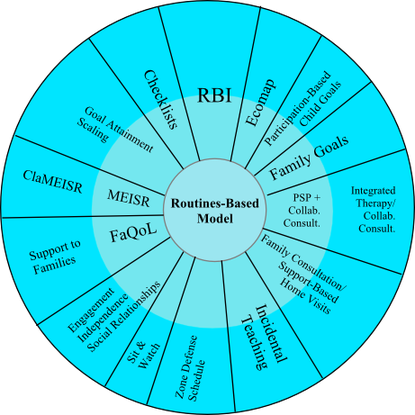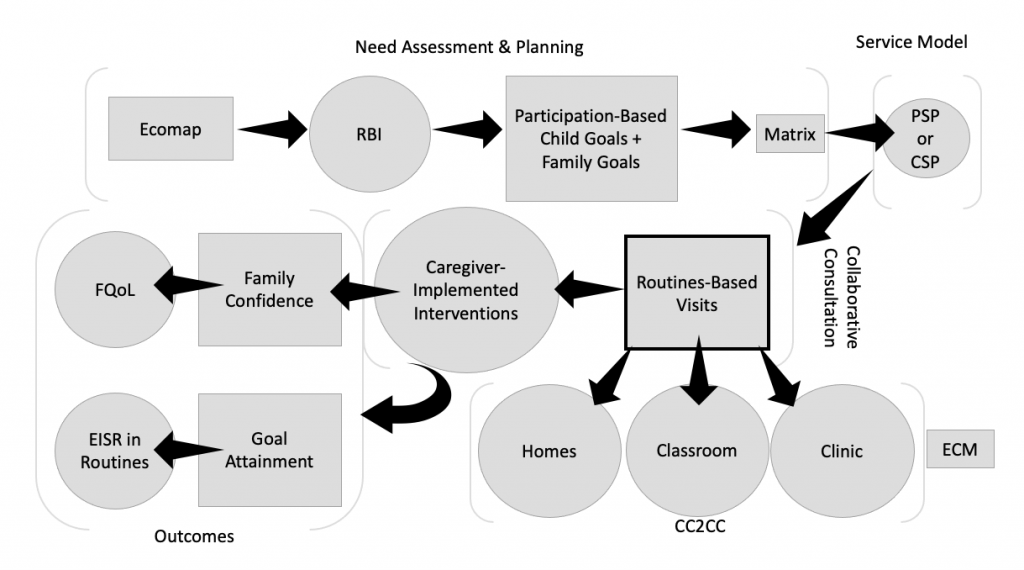The EIEIO is the academic and administrative home of the Routines-Based Model (RBM) of Early Intervention for children birth to 5 years with disabilities and their families. The EIEIO combines the efforts of researchers, trainers, and practitioners to conduct research and provide technical assistance to programs, states, and national programs.
What is the Routines-Based Model?
Over the past 30 years, McWilliam has developed the Routines-Based Model for working with young children with disabilities and their families. The whole model consists of components organized by (a) intervention planning, (b) providing supports (i.e., consultative service delivery), and (c) the Engagement Classroom Model. The video on the right shows Robin McWilliam discussing the model.
Training and Fidelity
How do professionals get trained in the model and know they have reached fidelity? Professionals can be trained in three ways: Attend an institute.
Intervention Planning
How to develop the intervention plan, including determining the family’s ecology and the family’s needs and writing child-level functional goals and family goals.
Ecomap:
How to determine and depict the family’s informal, intermediate, and formal supports.
Routines-Based Interview (RBI):
How to establish a positive relationship with the family, get a rich and thick description of child and family functioning, and get a list of family-chosen functional child-level participation-based goalsand family-level goals.
Participation-Based Child Goals:
How to write functional goals to emphasize participation in normal routines and to have meaningful acquisition, generalization, and maintenance criteria.
Family Goals:
How to ensure family goals are as important as child goals and are included in the list of goals to which we attend.
Consultative Service Delivery
How to conduct home- and community-based early intervention 0-5.
Support- and Routines-Based Home Visits:
How to conduct home visits focused on building the family’s capacity, through family consultation—a joint-problem-solving method of working with the family—similar to coaching.
Collaborative Consultation to Child Care (CC2CC) and Preschool:
How to make visits to the child’s classroom program, focused on building the teachers’ capacity through collaborative consultation, which is like coaching.

Engagement Classroom Model
How to organize and manage a classroom to promote engagement, independence, and social relationships.
RBI:
How to interview the family and the teacher, so the family can choose functional goals and family goals. Includes the ecomap and participation-based goals.
Incidental Teaching:
How to teach children by getting them engaged, following their lead, eliciting more sophisticated forms of their behavior, and ensuring the interaction was reinforcing.
Integrated Therapy:
How to provide specialized services in the classroom to build teachers’ capacity to use interventions throughout daily routines.
Teaching Styles:
How to use warm and fuzzy interactions with children to promote their engagement.
Zone Defense Schedule:
How to arrange the space, organize adults, and manage transitions to promote child engagement.
Reggio Emilia Concepts:
How to incorporate ideas from Reggio Emilia to make rooms aesthetically pleasing, activities based on projects, and children comfortable with art.

